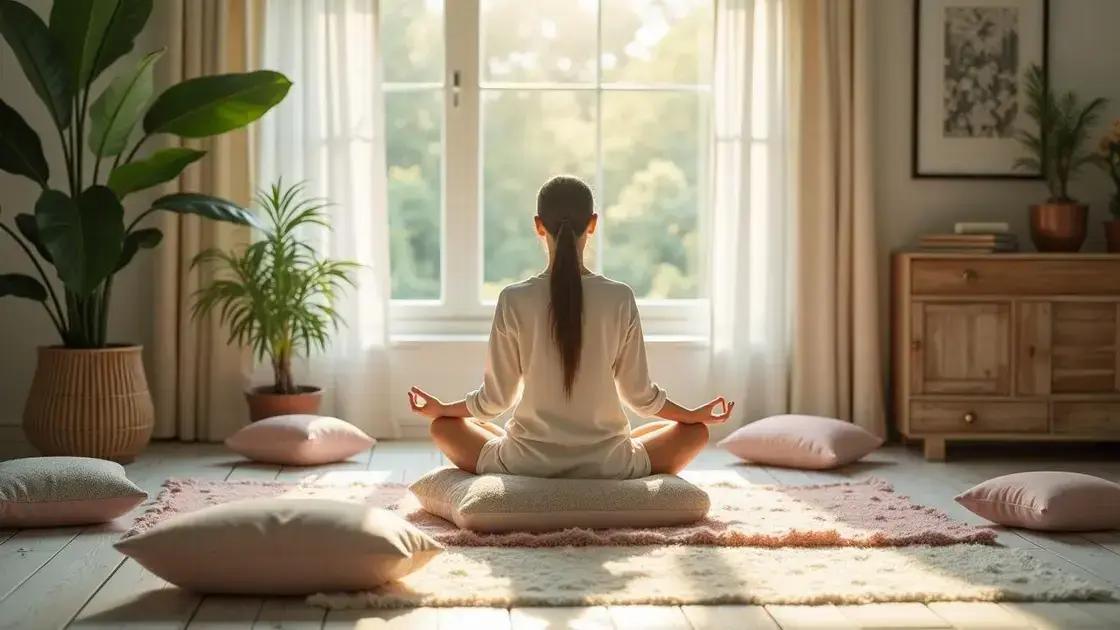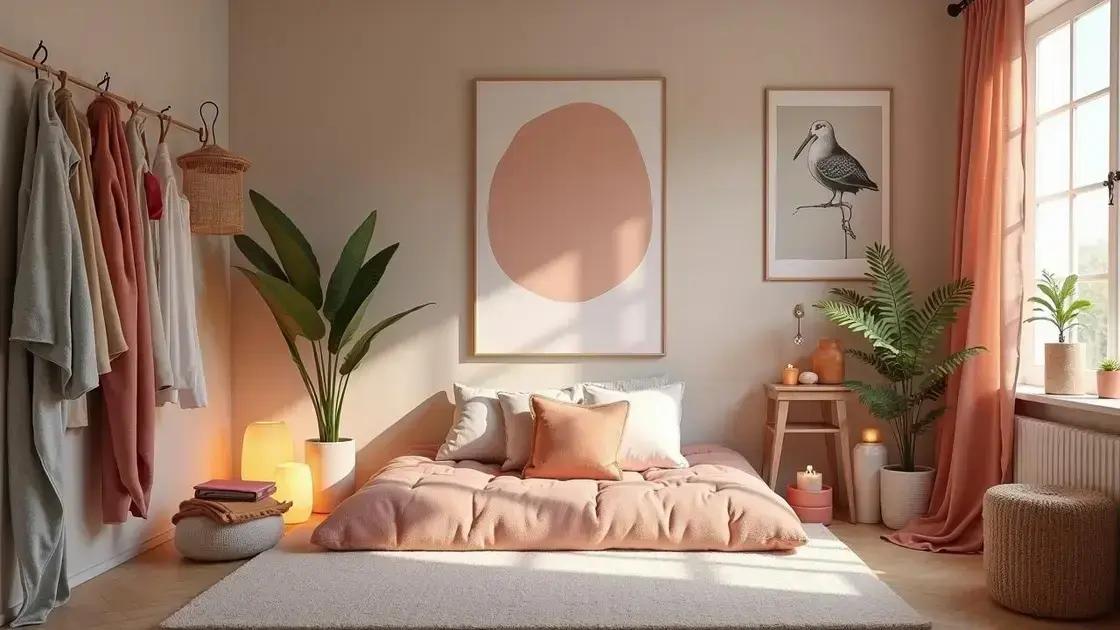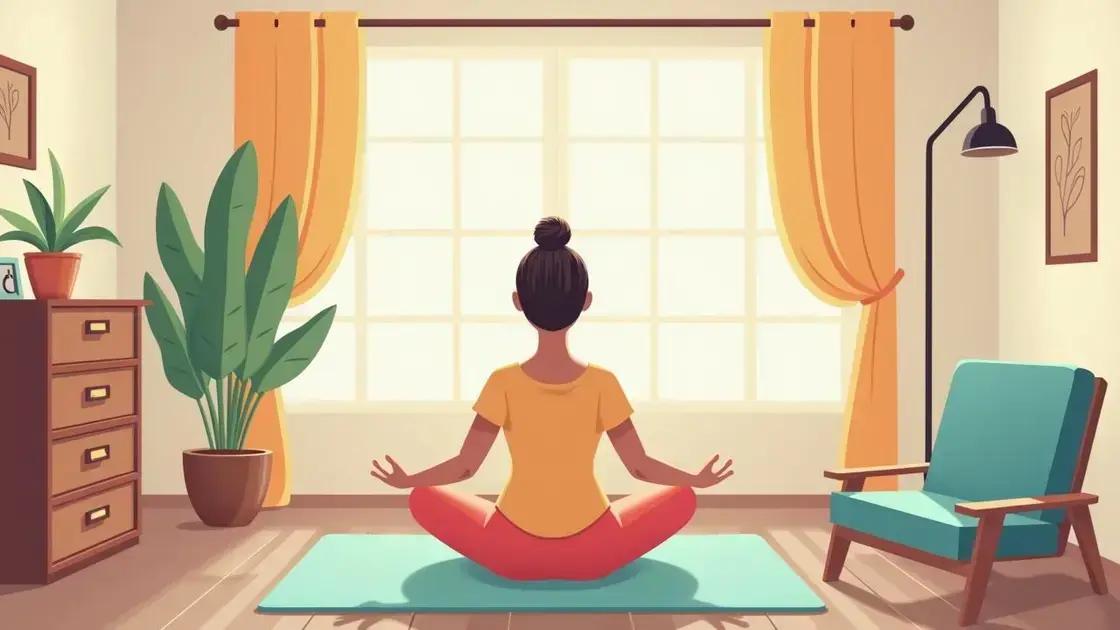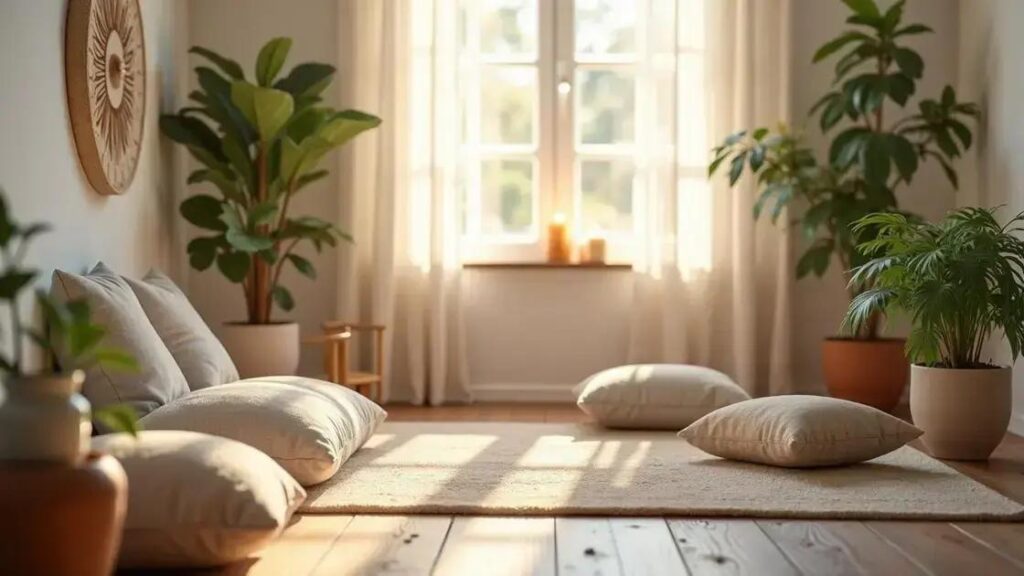To create a home meditation space for relaxation, choose a quiet spot, incorporate comfortable seating, utilize calming colors and scents, and personalize the area with meaningful items. Focus on creating a tranquil atmosphere with soft lighting and soothing sounds to enhance your meditation experience.
Creating a home meditation space for relaxation is essential for mental wellness and inner peace. In today’s fast-paced world, establishing a spot dedicated to meditation can significantly enhance your relaxation practices. This space serves as a sanctuary where you can retreat from daily stress, enjoy tranquility, and connect deeply with yourself. In this article, we will explore the benefits of having a meditation space, essential elements to include, tips for personalizing it, and how to create a calm atmosphere that promotes deep relaxation.
Understanding the Benefits of a Meditation Space

Having a meditation space in your home offers numerous benefits that can enhance your overall well-being. Firstly, it provides a dedicated area that fosters a peaceful mindset, making it easier to engage in mindfulness practices. When you meditate regularly in a specific spot, your brain associates that space with relaxation, reducing distractions and promoting focus.
Enhancing Mental Clarity
One significant advantage is improved mental clarity. A quiet meditation space allows you to clear your mind of clutter. This practice can lead to increased concentration, better decision-making, and enhanced creativity.
Reducing Stress Levels
Another key benefit is the reduction of stress levels. Meditation has been shown to lower cortisol, the stress hormone, which can help you feel calmer and more centered. Regular meditation in your home space can result in less anxiety and a greater sense of calm.
Boosting Emotional Well-Being
Creating a meditation area encourages you to spend time reflecting on your feelings. This can lead to improved emotional resilience. By engaging in self-reflection, you become better equipped to handle life’s challenges, leading to a more positive outlook.
Improving Physical Health
Additionally, meditation is linked to physical health improvements. Regular practice can lead to lower blood pressure, improved sleep, and enhanced immune function. Your meditation space can be a place to nurture both your mind and body.
In summary, understanding the benefits of a meditation space can motivate you to create one in your home. The advantages include enhanced mental clarity, reduced stress, improved emotional well-being, and better physical health.
Essential Elements for Your Home Meditation Area

To create a calming home meditation area, there are several essential elements that should be included. First and foremost is a comfortable seating option. This can range from a meditation cushion to a yoga mat or a comfortable chair that provides the right support without causing discomfort during your practice.
Choosing the Right Location
Selecting the right location is crucial. Find a quiet space in your home that is free from distractions. It should ideally have natural light and ventilation, providing a connection to the outside world.
Incorporating Nature
Bringing nature indoors can enhance your meditation experience. Consider adding plants or natural elements like stones and wood. These elements not only add beauty but also promote tranquility and fresh air.
Creating a Calming Atmosphere
Lighting plays a crucial role in establishing the mood. Use soft, warm lighting or candles to create a serene environment. If possible, use aromatherapy candles or essential oils to introduce calming scents that encourage relaxation.
Minimalistic Decor
Your meditation space should be minimalistic. Avoid clutter and distractions by keeping decorations simple. This simplicity allows your mind to focus on meditation rather than visual noise.
Lastly, consider incorporating soothing sounds. You can use a gentle water fountain or soft music to help create a peaceful ambiance that supports meditation.
Tips for Personalizing Your Meditation Space

Personalizing your meditation space can enhance your overall experience. Start by adding personal items that resonate with you. This could be a favorite picture, a statue, or anything that inspires peace and mindfulness.
Color Choices
Choose colors that make you feel calm. Soft, muted tones are ideal, but it’s essential to pick shades that you love. You might consider painting the walls light blue or green, or using colored cushions and throws that bring you joy.
Texture and Materials
Incorporate a variety of textures to create a cozy environment. Soft rugs, fluffy blankets, and smooth stones can all contribute to a more inviting space. These elements can encourage you to relax and settle into your practice.
Personalized Accessories
Add accessories that fit your meditation style. If you enjoy crystals, display your favorites in the space. Alternatively, consider having a journal nearby for reflection and note-taking after sessions. Incorporating items that support your practice will help you feel more connected.
Creative Lighting Options
Experiment with different lighting options to find what best suits your mood. You might use fairy lights for a soft glow or a Himalayan salt lamp for warm, soothing light. Finding the right light can significantly enhance the atmosphere for meditation.
Each personalization you make should reflect your unique preferences and what helps you feel most at peace. This will create a space that feels truly yours, making your meditation practice more enjoyable.
Creating a Calm Atmosphere for Meditation

Creating a calm atmosphere for meditation is vital for achieving a peaceful mind. Start by ensuring your space is quiet and free from disturbances. If possible, choose a room furthest from noise sources like traffic, and avoid areas with frequent foot traffic.
Sound Control
Consider using soft background sounds or calming music to mask any distracting noises. You might try nature sounds like flowing water or birds chirping. White noise machines can also help create a soothing environment.
Comfortable Temperature
Ensure the temperature in your meditation area is comfortable. A space that is too hot or too cold can make it hard to relax. Use fans or heaters as needed, and dress in layers to stay comfortable throughout your meditation session.
Scent and Aromatherapy
Aromatherapy is another powerful tool for creating a calm atmosphere. Use essential oils like lavender or sandalwood to promote relaxation. You can diffuse oils in the air or use scented candles to fill the space with calming fragrances.
Decluttering the Space
Clutter can create a sense of chaos. Keep your meditation area organized and minimalistic. Remove unnecessary items that might distract your mind, leaving only what is essential for your practice.
Implementing these steps will help you create a serene and inviting atmosphere that encourages a focused and peaceful meditation experience.
Creating Your Perfect Meditation Space
As we have explored, crafting a home meditation space for relaxation involves several key elements, from understanding the benefits of meditation to effectively personalizing your area. Each aspect, such as choosing the right location, incorporating calming colors, adding personal touches, and creating a tranquil atmosphere, plays a vital role in enhancing your meditation practice.
It’s essential to prioritize both comfort and peace in your space, ensuring it’s a sanctuary where you can unwind and reconnect with yourself. By taking the time to thoughtfully design your meditation area, you will foster a deeper connection to your mindfulness practices.
Ultimately, your home meditation space should reflect your unique style and needs, making it an easy and inviting environment for relaxation and self-discovery. Embrace your journey of creating this calming haven and enjoy the benefits it brings to your overall well-being.
FAQ – Frequently Asked Questions About Creating a Home Meditation Space
What are the essential elements for a meditation space?
The essential elements for a meditation space include comfortable seating, a quiet location, calming colors, and minimalistic decor to reduce distractions.
How can I personalize my meditation area?
You can personalize your meditation area by adding items that inspire you, choosing colors that calm you, and incorporating textures or scents that enhance relaxation.
What should I consider when choosing a location for my meditation space?
Select a quiet space far from noise and distractions, ideally with natural light and good ventilation, to create an inviting environment for meditation.
How can I create a calm atmosphere for meditation?
To create a calm atmosphere, focus on controlling sound, ensuring a comfortable temperature, using aromatherapy, and decluttering the space for a more peaceful vibe.
What types of lighting are best for a meditation space?
Soft, warm lighting is ideal for a meditation space. You can use candles, salt lamps, or dimmable lights to create a serene ambiance.
Why is it important to have a dedicated meditation space?
A dedicated meditation space helps condition your mind to focus, reduces distractions, and allows for a more immersive practice, enhancing your overall meditation experience.












